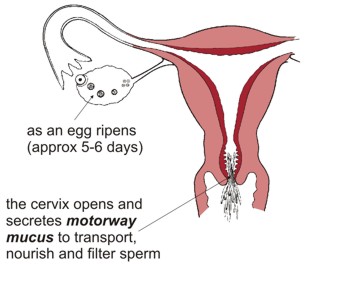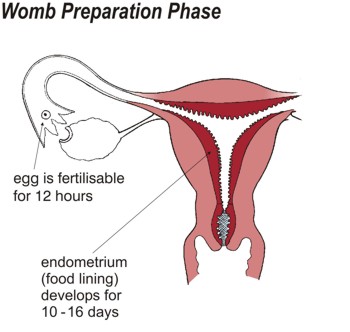understanding your fertility, page 6 of 14
Onset of the Fertile Time

Eventually, at some point after the period, the egg for that cycle will be chosen and its follicle will grow very quickly in
the ovary. In approximately six days, it will be ready to burst and shed its egg - ovulation.
(This growth spurt can be seen very clearly with ultrasound.)
As already explained, the cervix opens and changes the mesh mucus into “motorway” mucus, which is alkaline and rich in nutrients. The woman is in the fertile phase of her cycle!
Now sperm can enter the cervix and survive in little pockets in the walls (cervical crypts) for several days. They are primed and given the qualities they need to reach and fertilise the egg. At first, the “motorway” mucus looks cloudy and wet. Nearer ovulation, it becomes more clear, abundant, stretchy and slippery like raw egg-white.

the stage is now set for the high point of the cycle - ovulation!
To burst the follicle and release the egg, a new hormone called Luteinising Hormone (LH) is sent by the brain. (Test kits for this hormone can be bought in pharmacies).
The released egg is sucked into the fallopian tubes and now remains fertilisable for about 12 hours.
The ruptured follicle is not wasted. Instead, it is re-cycled to become the Corpus Luteum, which produces the next hormone called Progesterone (pregnancy hormone).
Progesterone stops any further ovulations, thickens the mucus to seal the womb and builds up the womb lining (endometrium) ready to receive and nourish the baby, if conceived. Every cycle is the same up to this point. Whether conception occurs or not will all depend on whether the couple had intercourse in the fertile phase of the cycle, when the motorway mucus was present. The next page shows a conception cycle.
- Previous |
- Next |
- Exit Tutorial |
- Help |
- Download as a PDF
© 2011 Fertility Education & Training